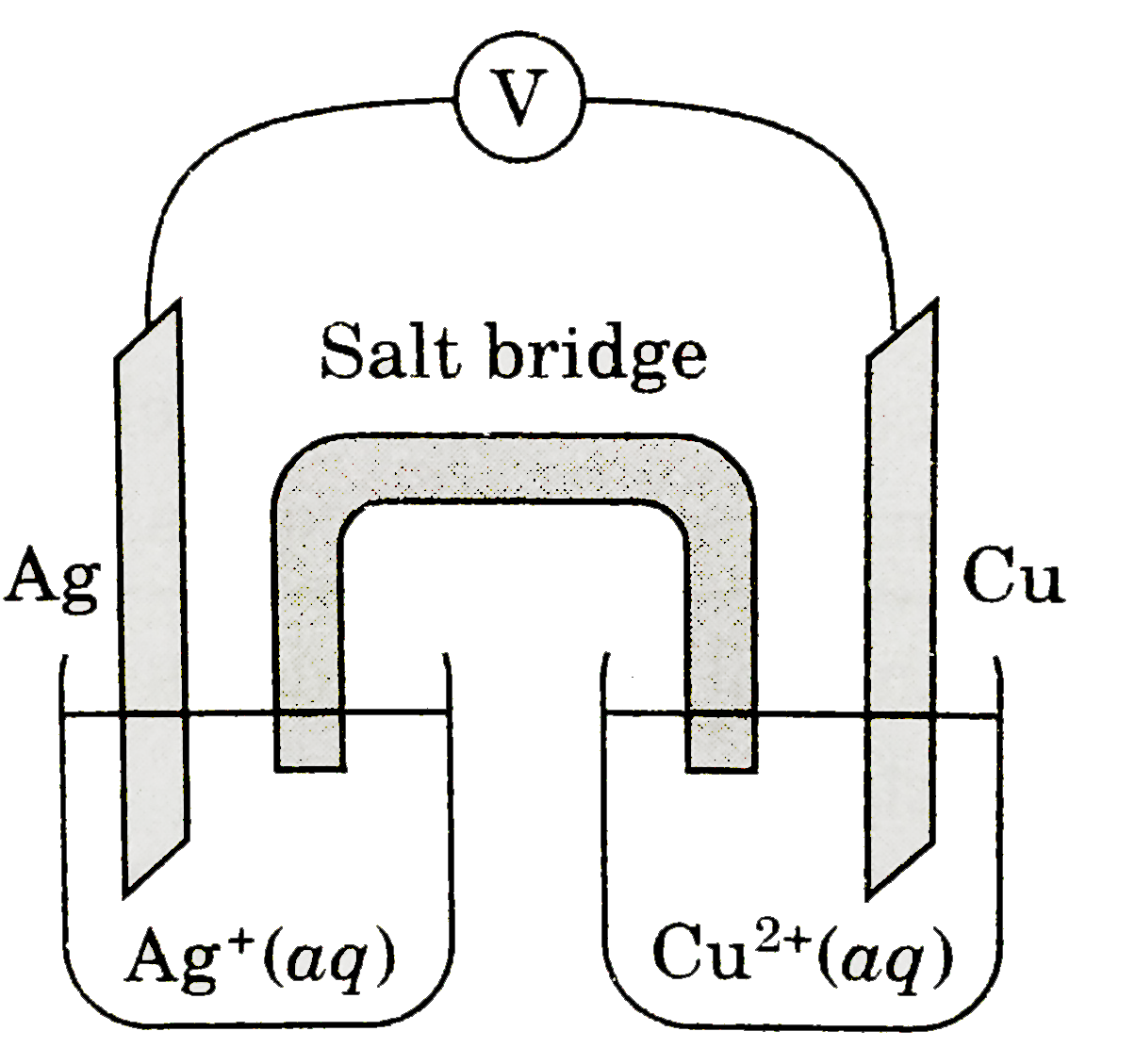(a) Following reactions occur at cathode during the electrolysis of aqueous silver chloride solution :
Ag+(aq)+e−→Ag(s),E°=+0.80V
H+(aq)+e−→12H2(g),E∘=0.00V
On the basis of their standard reduction electrode potential (E°) values, which reaction is feasible at the cathode and why? (b) Define limiting molar conductivity. Why conductivity of an electrolyte solution decreases with the decrease in concentration ?
(a) The reaction with a higher value of electrode potential is preferred. Hence Ag+ will be deposited in preference to H+.
Ag+(aq)+e−→Ag(s)
(b) When the concentration of the solution approaches zero, molar conductivity is called limiting molar conductivity. Conductivity of an electrolyte solution decreases with decrease in concentration. Conductivity of a solution at any concentration is the conductance of one unit volume of the solution kept between platinum electrodes with unit area of cross section and at a distance of unit length. With dilution, the number of ions per unit volume decreases. Therefore conductivity of the solution decreases with decrease in concentration.
Topper's Solved these Questions
- ELECTROCHEMISTRY BOOK - U-LIKE SERIESCHAPTER - ELECTROCHEMISTRY EXERCISE - CASE BASED/SOURCE-BASED INTEGRATED QUESTIONS (LONG ANSWER QUESTIONS-I (3 MARKS EACH))
27 Videos
- ELECTROCHEMISTRY BOOK - U-LIKE SERIESCHAPTER - ELECTROCHEMISTRY EXERCISE - CASE BASED/SOURCE-BASED INTEGRATED QUESTIONS (LONG ANSWER QUESTIONS-II (5 MARKS EACH))
16 Videos
- ELECTROCHEMISTRY BOOK - U-LIKE SERIESCHAPTER - ELECTROCHEMISTRY EXERCISE - CASE BASED/SOURCE-BASED INTEGRATED QUESTIONS (VERY SHORT ANSWER QUESTIONS (1 MARK EACH))
47 Videos
- COORDINATION COMPOUNDSBOOK - U-LIKE SERIESCHAPTER - COORDINATION COMPOUNDSEXERCISE - SELF ASSESSMENT TEST
7 Videos
- EXAMINATION PAPER 2020BOOK - U-LIKE SERIESCHAPTER - EXAMINATION PAPER 2020EXERCISE - SECTION D
15 Videos
Similar Questions
Following reactions occur at cathode during electrolysis of aqueous silver chloride solution :
Ag+(aq)+e−→Ag(s),E∘=+0.80 V
H+(aq)+e−→1/2H2(g),E∘=0.00 V
On the basis of standard reduction potential (E∘ value), which reaction is feasible at cathode and why ?
View SolutionFollowing reactions occur at cathode during electrolysis of aqueous silver chloride solution :
Ag+(aq)+e−→Ag(s),E∘=+0.80 V
H+(aq)+e−→1/2H2(g),E∘=0.00 V
On the basis of standard reduction potential (E∘ value), which reaction is feasible at cathode and why ?
View Solution
Knowledge Check
Ag+(aq)+e−→Ag(s) E∘=0.80V
Co2+(aq)+2e(−)→Co(s) E∘=−0.28V
Use the standard reduction potentials to determine the standard potential for the reaction:
Co(s)+2Ag+(aq□)→Co2+(aq)+2Ag(s)A0.52VB0.66VC1.08VD1.88VAg+(aq)+e−→Ag(s)E∘=0.80V
Cu2+(aq)+2e−→Cu(s)E∘=0.34V

Which increases immediately if the surface area of the silver electrode is increased?AOverall cell voltageBRate of change of [Ag+]CMass of Cu electrodeDChange in ratio of electrode masses Δ(Mass of CuMass of Ag)
Following reactions occur at cathode during the electrolysis of aqueous copper (II) chloride solution:
CU2+(aq)+2e−→Cus, E∘=+0.34V
H+(aq)+e−→12H2(s), E∘=0.00V
On the basis of their standard reduction electrode potential (E∘) values, which reaction is feasible at the cathode and why?
View SolutionFollowing reactions occur at cathode during the electrolysis of aqueous copper (II) chloride solution:
CU2+(aq)+2e−→Cus, E∘=+0.34V
H+(aq)+e−→12H2(s), E∘=0.00V
On the basis of their standard reduction electrode potential (E∘) values, which reaction is feasible at the cathode and why?
View Solution(a) Following reactions occur at cathode during the electrolysis of aqueous copper (II) chloride solution :
1Cu2+(aq)+2e−→Cu(s),E°=+0.34V
H++(aq)+e−→12H2 (g)
On the basis of their standard reduction electrode potential (E°) values, which reaction is feasible at the cathode and why?
(b) State Kohlrausch law of independent migration of ions. Write its one application.
View SolutionFollowing reactions can occur at cathode during the electrolysis of aqueous silver nitrate solution using Pt electrodes :
Ag+(aq)+e−→Ag(s),E∘=0.80V
H+(aq)+e−→12H2(g),E∘=0.00V
On the basis of theri standars electrode protential values, which reaction is feasible at cathode and why ?
View SolutionFollowing reactions can occur at cathode during the electrolysis of aqueous silver nitrate solution using Pt electrodes :
Ag+(aq)+e−→Ag(s),E∘=0.80V
H+(aq)+e−→12H2(g),E∘=0.00V
On the basis of theri standars electrode protential values, which reaction is feasible at cathode and why ?
View SolutionFollowing two reactions can occur at cathode in the electrolysis of aqueous sodium chloride
Na++e−→Na(s),EΘred=−2.71V
View Solution
